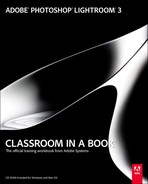Getting Started
Adobe® Photoshop® Lightroom® delivers a complete workflow solution for the digital photographer—from importing, reviewing, organizing, and enhancing digital images to publishing photos, producing client presentations, creating web galleries, and outputting high-quality prints. The user interface is highly intuitive and easy to learn, yet Lightroom has all the power and versatility you would expect from an Adobe application, utilizing state-of-the-art technologies to manage large volumes of digital photographs and to perform sophisticated image processing tasks. Whether you’re a home user, a professional photographer, a hobbyist, or a business user, Lightroom enables you to stay in control of your growing digital photo library and to easily produce good-looking pictures and polished presentations for both web and print.
If you’ve used an earlier version of Lightroom, you’ll find that this Classroom in a Book® will teach you advanced skills and covers the many new innovative features that Adobe Systems has introduced in this version. If you’re new to Lightroom, you’ll learn the fundamental concepts and techniques that will help you master the application.
About Classroom in a Book
Adobe Photoshop Lightroom 3 Classroom in a Book is part of the official training series for Adobe graphics and publishing software developed with the support of Adobe product experts. Each lesson in this book is made up of a series of self-paced projects that give you hands-on experience using Adobe Photoshop Lightroom 3.
Adobe Photoshop Lightroom 3 Classroom in a Book includes a CD attached to the inside back cover. On the CD you’ll find all the image files used for the lessons in this book, along with additional learning resources.
Prerequisites
Before starting on the lessons in this book, make sure that you and your computer are ready by following the tips and instructions on the next few pages.
Requirements on your Computer
You’ll need about 400 MB of free space on your hard disk for the lesson files and the work files that you’ll create as you work through the exercises.
Required Skills
The lessons in this book assume that you have a working knowledge of your computer and its operating system. Make sure that you know how to use the mouse and the standard menus and commands, and also how to open, save, and close files. Can you scroll (vertically and horizontally) within a window to see content that may not be visible in the displayed area? Do you know how to use context menus, which open when you right-click (Windows) / Control-click (Mac OS) items?
If you need to review these basic and generic computer skills, see the documentation included with your Microsoft® Windows® or Apple® Mac® OS X software.
Installing Adobe Photoshop Lightroom
Before you begin using Adobe Photoshop Lightroom 3 Classroom in a Book, make sure that your system is set up correctly and that you’ve installed the required software and hardware.
You must purchase the Adobe Photoshop Lightroom 3 software separately. For system requirements and complete instructions on installing the software, see the Adobe Photoshop Lightroom 3 Read Me file on the application CD or the Adobe Photoshop Lightroom Support Center on the web at www.adobe.com/support/ photoshoplightroom.
Copying the Classroom in a Book files
The CD attached to the inside back cover of this book includes a Lessons folder containing all the image files you’ll need for the lessons. You’ll import these images into your Lightroom library and learn to organize them using the catalog that is central to many of the projects in this book. Keep the lesson files on your computer until you have completed all the exercises.
![]() Note: The files on the CD are practice files, provided for your personal use in these lessons. You are not authorized to use these files commercially, or to publish or distribute them in any form without written permission from Adobe Systems, Inc. and the individual photographers who took the pictures, or other copyright holders.
Note: The files on the CD are practice files, provided for your personal use in these lessons. You are not authorized to use these files commercially, or to publish or distribute them in any form without written permission from Adobe Systems, Inc. and the individual photographers who took the pictures, or other copyright holders.
Copying the Lesson files from the C
1 Create a new folder named LR3CIB inside the username/My Documents (Windows) or username/Documents (Mac OS) folder on your computer.
2 Insert the Adobe Photoshop Lightroom 3 Classroom in a Book CD into your CD-ROM drive.
3 Locate the Lessons folder on the CD and copy it into the LR3CIB folder you created in step 1.
4 When your computer finishes copying the Lessons folder, remove the CD from your CD-ROM drive and put it away.
Creating a catalog file for working with this book
The catalog file stores information about all the photos in your library. It includes the location of the master files, any metadata you’ve added in the process of organizing your images, and a record of every adjustment or edit you’ve made. Most users will keep all their photos in a single catalog, which can easily manage thousands of files. Some might want to create separate catalogs for different purposes, such as home photos and business photos. Although you can create multiple catalogs, you can only have one catalog open in Lightroom at a time.
For the purposes of working with this book, you’ll create a new catalog to manage the image files that you’ll use in the lessons. This will allow you to leave the default catalog untouched while working through the lessons, and to keep your lesson files together in one easy-to-remember location.
Creating a library folder
First you’ll create a folder to contain your new catalog as well as the files that you’ll create as you complete the lessons in this book.
1 Locate the LR3CIB folder you’ve created on your computer.
2 Within that folder, create a new folder called LR3CIB Library. This new folder should be located right next to the Lessons folder that you’ve just copied from the CD.
Creating a new catalog file
The first time you launch Lightroom, a catalog file named Lightroom Catalog.lrcat is automatically created on your hard disk. This default Lightroom catalog file is created in the username/My Documents/My Pictures/Lightroom (Windows) or username/Pictures/Lightroom (Mac OS) folder.
You’ll create your new catalog file inside your LR3CIB Library folder.
1 Start Adobe Photoshop Lightroom 3.
2 From the Lightroom menu bar, choose File > New Catalog.
3 In the Create Folder With New Catalog dialog box, navigate to the LR3CIB Library folder inside the LR3CIB folder you created on your hard disk.
![]() Note: In this book, the forward arrow character (>) is used to denote submenus and commands found in the menu bar at the top of the workspace or in context menus; for example, Menu > Sub-menu > Command.
Note: In this book, the forward arrow character (>) is used to denote submenus and commands found in the menu bar at the top of the workspace or in context menus; for example, Menu > Sub-menu > Command.
4 Create a new catalog by doing one of the following:
• On Windows, type LR3CIB Library Catalog in the File Name text box, and then click Save.
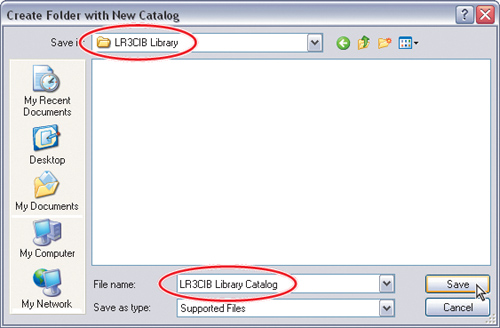
• On Mac OS, type LR3CIB Library Catalog in the Save As text box, and then click Create.
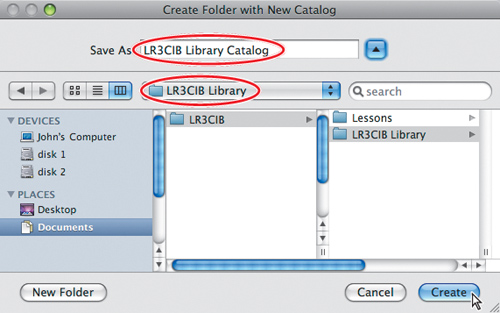
Lightroom opens your new library catalog, which is empty as you have not yet imported any photos.
In order to be sure that you’re always working with the right catalog as you progress through the lessons in this book, you will now set the preferences so that you will be prompted to specify the LR3CIB catalog each time you launch Lightroom. It is recommended that you keep this preference set as long as you’re working through the lessons in this book.
5 Choose Edit > Preferences (Windows) / Lightroom > Preferences (Mac OS).
6 In the Preferences dialog box, click the General tab. From the Default Catalog menu, choose Prompt Me When Starting Lightroom.
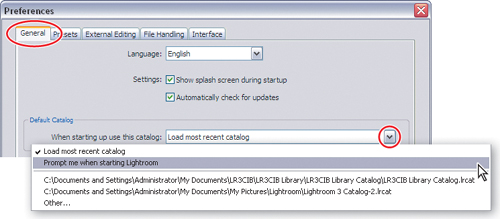
![]() Note: In the remainder of this book, instructions that differ for Macintosh users and those working on Windows systems are given in a compact format as follows; the forward slash character (/) is used to separate equivalent terms and commands for Windows / Mac OS, in the order shown here.
Note: In the remainder of this book, instructions that differ for Macintosh users and those working on Windows systems are given in a compact format as follows; the forward slash character (/) is used to separate equivalent terms and commands for Windows / Mac OS, in the order shown here.
7 Click OK (Windows) / the Close button (![]() ) (Mac OS) to close the Preferences dialog box.
) (Mac OS) to close the Preferences dialog box.
Next time you start Lightroom the Select Catalog dialog box will appear, giving you the opportunity to make sure that your LR3CIB Library Catalog is selected before Lightroom launches.
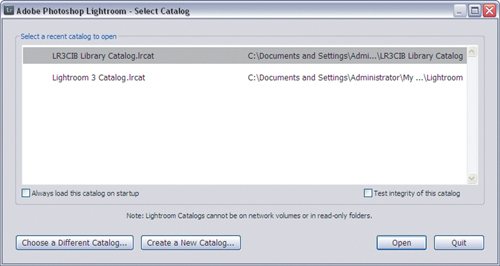
![]() Tip: You can hold down the Clrl+Alt / Control+Option keys immediately after you launch Lightroom to open the Select Catalog dialog box regardless of your Default Catalog preference settings.
Tip: You can hold down the Clrl+Alt / Control+Option keys immediately after you launch Lightroom to open the Select Catalog dialog box regardless of your Default Catalog preference settings.
Additional resources
Adobe Photoshop Lightroom 3 Classroom in a Book is not meant to replace documentation that comes with the program or to be a comprehensive reference for every feature. Only the commands and options used in the lessons are explained in this book. For comprehensive information about program features and tutorials, please refer to these resources:
Adobe Community Help Community Help brings together active Adobe product users, Adobe product team members, authors, and experts to give you the most useful, relevant, and up-to-date information about Adobe products. Whether you’re looking for a code sample or an answer to a problem, have a question about the software, or want to share a useful tip or recipe, you’ll benefit from Community Help. Search results will show you not only content from Adobe, but also from the community. With Adobe Community Help you can:
• Access up-to-date definitive reference content online and offline
• Find the most relevant content contributed by experts from the Adobe community, on and off Adobe.com
• Comment on, rate, and contribute to content in the Adobe community
• Download Help content directly to your desktop for offline use
• Find related content with dynamic search and navigation tools
To access Community Help If you have any Adobe CS5 product, then you already have the Community Help application. To invoke Help, press F1 or choose Help Lightroom help. This companion application lets you search and browse Adobe and community content, and to comment on and rate any article just as you would in the browser.
You can also download Adobe Help and language reference content for use offline, and subscribe to new content updates (which can be downloaded automatically) so that you’ll always have the most up-to-date content for your Adobe product. You can download the application from www.adobe.com/support/chc/index.html
Adobe content is updated based on community feedback and contributions. You can contribute in several ways: add comments to content or forums—including links to web content, publish your own content using Community Publishing, or contribute Cookbook Recipes. Find out how to contribute at www.adobe.com/community/publishing/download.html
See http://community.adobe.com/help/profile/faq.html for answers to frequently asked questions about Community Help.
Adobe Photoshop Lightroom 3 Help and Support www.adobe.com/support/photoshoplightroom where you can find and browse Help and Support content on adobe.com.
Adobe TV http://tv.adobe.com is an online video resource for expert instruction and inspiration about Adobe products, including a How To channel to get you started with your product.
Adobe Design Center www.adobe.com/designcenter offers thoughtful articles on design and design issues, a gallery showcasing the work of top-notch designers, tutorials, and more.
Adobe Developer Connection www.adobe.com/devnet is your source for technical articles, code samples, and how-to videos that cover Adobe developer products and technologies.
Resources for educators www.adobe.com/education includes three free curriculums that use an integrated approach to teaching Adobe software and can be used to prepare for the Adobe Certified Associate exams.
Also check out these useful links:
Adobe Forums http://forums.adobe.com lets you tap into peer-to-peer discussions, questions and answers on Adobe products.
Adobe Marketplace & Exchange www.adobe.com/cfusion/exchange is a central resource for finding tools, services, extensions, code samples and more to supplement and extend your Adobe products.
Adobe Photoshop Lightroom 3 product home page
http://www.adobe.com/products/photoshoplightroom.
Adobe Labs http://labs.adobe.com gives you access to early builds of cutting-edge technology, as well as forums where you can interact with both the Adobe development teams building that technology and other like-minded members of the community.
Adobe certification
The Adobe training and certification programs are designed to help Adobe customers improve and promote their product-proficiency skills. There are four levels of certification:
• Adobe Certified Associate (ACA)
• Adobe Certified Expert (ACE)
• Adobe Certified Instructor (ACI)
• Adobe Authorized Training Center (AATC)
The Adobe Certified Associate (ACA) credential certifies that individuals have the entry-level skills to plan, design, build, and maintain effective communications using different forms of digital media.
The Adobe Certified Expert program is a way for expert users to upgrade their credentials. You can use Adobe certification as a catalyst for getting a raise, finding a job, or promoting your expertise.
If you are an ACE-level instructor, the Adobe Certified Instructor program takes your skills to the next level and gives you access to a wide range of Adobe resources.
Adobe Authorized Training Centers offer instructor-led courses and training on Adobe products, employing only Adobe Certified Instructors. A directory of AATCs is available at http://partners.adobe.com.
For information on the Adobe Certified programs, visit www.adobe.com/support/certification/main.html.
